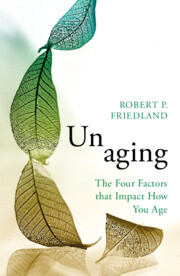Book contents
- Unaging
- Reviews
- Unaging
- Copyright page
- Dedication
- Contents
- List of Figures and Tables
- Preface
- Part I Foundations: What Do We Need to Know about Optimal Aging?
- Part II Applications: What Can We Do about the Opportunity of Aging?
- 12 Overview
- 13 Physical Activity
- 14 Whole Body Health
- 15 Mental Activity
- 16 Psychological Measures
- 17 Social Factors
- 18 Dealing with Stress
- 19 Sleep
- 20 Diet
- 21 Microbial Considerations
- 22 Dental Care
- 23 Dealing with Doctors and Drugs
- 24 Hazardous Behaviors
- 25 Toxic Exposures
- Part III Conclusions
- Acknowledgments
- Glossary
- References
- Index
13 - Physical Activity
from Part II - Applications: What Can We Do about the Opportunity of Aging?
Published online by Cambridge University Press: 15 September 2022
- Unaging
- Reviews
- Unaging
- Copyright page
- Dedication
- Contents
- List of Figures and Tables
- Preface
- Part I Foundations: What Do We Need to Know about Optimal Aging?
- Part II Applications: What Can We Do about the Opportunity of Aging?
- 12 Overview
- 13 Physical Activity
- 14 Whole Body Health
- 15 Mental Activity
- 16 Psychological Measures
- 17 Social Factors
- 18 Dealing with Stress
- 19 Sleep
- 20 Diet
- 21 Microbial Considerations
- 22 Dental Care
- 23 Dealing with Doctors and Drugs
- 24 Hazardous Behaviors
- 25 Toxic Exposures
- Part III Conclusions
- Acknowledgments
- Glossary
- References
- Index
Summary
We are not prepared by our genes for a sedentary lifestyle. Studies have shown that higher levels of physical activity throughout life are very good for you. Physical activity leads to good physical reserve and has beneficial effects on development of Alzheimer’s, as well as stroke, cardiovascular disease, and depression, in both humans and animals. It increases the production of new neurons in the brain that activates learning and also enhances the production of growth factors which can facilitate the communication among neurons and the maintenance of mental function. Exercise also enhances the immune system, producing more protective cells and antibodies and assists with skeletal, endocrine, and cardiac health. The function of blood vessels in the heart, brain, and everywhere in the body is enhanced with exercise. Research has shown that people who become less physically and mentally active in the years from midlife to later life have a higher risk of developing Alzheimer’s, compared to those whose participation stayed the same or became more active. Almost everyone is capable of some physical activity. Two rules of physical exercise must be followed: 1. Start; 2. Continue.
- Type
- Chapter
- Information
- UnagingThe Four Factors that Impact How You Age, pp. 192 - 197Publisher: Cambridge University PressPrint publication year: 2022

